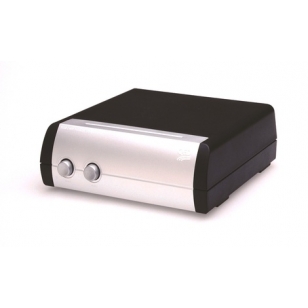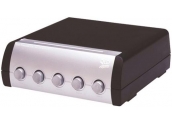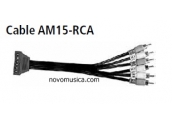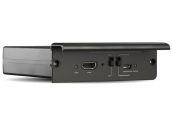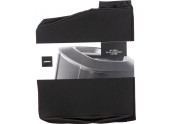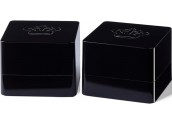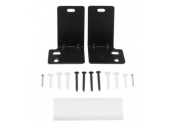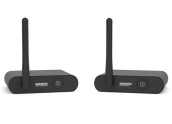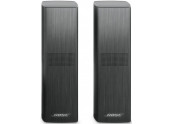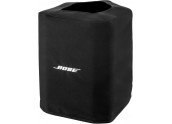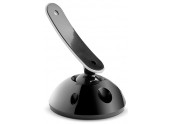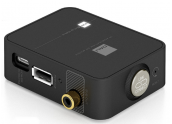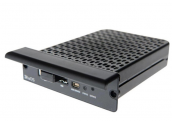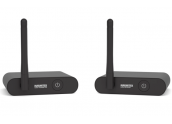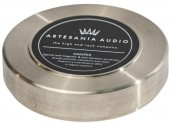QED SS20-2
QED SS20-2 conmutador 2 parejas de altavoces en pararelo | A partir de un amplificador estéreo | Potencia RMS 150W | Electrónicamente protegido contra sobrecargas
QED SS20-2
Todos los conmutadores de altavoces están configurados de forma que si utilizas altavoces de 8 Ω la impedancia mínima que verá el amplificador será de 4 Ω
¿CUÁLES SON LAS VENTAJAS DE LA CONEXIÓN EN SERIE FRENTE A LA CONEXIÓN EN PARALELO?
Los conmutadores que tienen más de dos juegos de altavoces utilizan una combinación de conmutación en serie y en paralelo para conseguir la impedancia mínima de 4 Ω independientemente de la combinación de altavoces que se conecte. Para los conmutadores de dos vías se puede elegir entre versiones exclusivamente en serie o en paralelo. Si tiene altavoces de 8 Ω (y un amplificador de 4 Ω como mínimo) debe utilizar siempre el conmutador en paralelo. Si tiene altavoces de 4 Ω y un amplificador de 4 Ω mín. debe utilizar siempre el conmutador en serie.
TODOS LOS CONMUTADORES QED CARGAN EN 4 Ω UTILIZANDO ALTAVOCES DE 8 Ω. ¿QUÉ OCURRE SI MIS ALTAVOCES SON DE 6 Ω?
1. Compruebe su amplificador: si puede soportar una carga de 3 Ω o menos (y algunos pueden), entonces no hay problema. La norma es utilizar siempre altavoces con el doble de impedancia que el amplificador como mínimo. 2. Si sólo tiene dos pares de altavoces, utilice el conmutador SERIES de dos vías.
¿CÓMO ACTÚAN LOS INTERRUPTORES CON LA POTENCIA, POR EJEMPLO, SI TENGO UN AMPLIFICADOR DE MÁS DE 150 VATIOS?
Estos accesorios utilizan interruptores de red con una capacidad nominal de 6 A, lo que significa que la potencia máxima que pueden soportar es de 288 W con una carga de 8 Ω.
¿INTERRUPTORES DE ALTAVOZ EN TÉRMINOS DE IMPEDANCIA?
Todos los conmutadores de altavoces están configurados de modo que si utiliza altavoces de 8 Ω, la impedancia mínima que verá el amplificador será de 4 Ω.
¿QUÉ VENTAJAS TIENEN LOS CONMUTADORES EN SERIE FRENTE A LOS CONMUTADORES EN PARALELO?
Los conmutadores que tienen más de dos juegos de altavoces utilizan una combinación de conmutación en serie y en paralelo para conseguir la impedancia mínima de 4 Ω independientemente de la combinación de altavoces que se conecte. Para los conmutadores de dos vías se puede elegir entre versiones exclusivamente en serie o en paralelo. Si tiene altavoces de 8 Ω (y un amplificador de 4 Ω como mínimo) debe utilizar siempre el conmutador en paralelo. Si tiene altavoces de 4 Ω y un amplificador de 4 Ω mín. debe utilizar siempre el conmutador en serie.
TODOS LOS CONMUTADORES QED CARGAN EN 4 Ω UTILIZANDO ALTAVOCES DE 8 Ω. ¿QUÉ OCURRE SI MIS ALTAVOCES SON DE 6 Ω?
1. Compruebe su amplificador: si puede soportar una carga de 3 Ω o menos (y algunos pueden), entonces no hay problema. La norma es utilizar siempre altavoces con el doble de impedancia que el amplificador como mínimo. 2. Si sólo tiene dos pares de altavoces, utilice el conmutador SERIES de dos vías.
¿CÓMO ACTÚAN LOS INTERRUPTORES CON LA POTENCIA, POR EJEMPLO, SI TENGO UN AMPLIFICADOR DE MÁS DE 150 VATIOS?
Estos accesorios utilizan interruptores de red con una potencia nominal de 6 A, lo que significa que la potencia máxima que pueden manejar es de 288 W con una carga de 8 Ω.
SI MI AMPLIFICADOR TIENE UNA POTENCIA NOMINAL DE 6-16 Ω, ¿DEBERÍA UTILIZAR UNA CARGA DE 4 Ω?
NO, NUNCA - debe utilizar altavoces de 12 Ω como mínimo. Puede conseguir altavoces de 16 Ω, pero puede que sea más fácil cambiar el amplificador.
¿PUEDO UTILIZARLOS EN SENTIDO INVERSO, POR EJEMPLO, COMO CONMUTADOR DE AMPLIFICADOR (SABEMOS QUE LA RESPUESTA ES NO, PERO POR QUÉ?)
NO - porque los conmutadores de altavoces están diseñados para tener dos juegos o más de altavoces conectados a un amplificador, si se utilizan a la inversa siempre existe la posibilidad de conectar dos amplificadores a la vez a un par de altavoces resultando en daños a uno o ambos amplificadores.
¿CUÁL ES LA DEFINICIÓN TÉCNICA DE 'TRANSMATCH'?
Para el conmutador de altavoces de 5 vías no utilizamos conmutación en paralelo o en serie, sino que en su lugar utilizamos acoplamiento por transformador. De nuevo, tiene que utilizar altavoces de 8 Ω como mínimo si su amplificador es de 4 Ω como mínimo. El transformador iguala la impedancia (de ahí el nombre) de modo que una carga neta de 1,6 Ω (los 5 juegos de altavoces de 8 Ω conectados) se convierte de nuevo en una carga de 4 Ω. Un par de altavoces (A) no está conectado al transformador, sino directamente al amplificador; serán los altavoces principales. Los cuatro pares B se conectan a través del transformador.
ADECUADO PARA SU USO CON EL CONTROL DE VOLUMEN DE PARED WM14
ESPECIFICACIONES
- Impedancia de carga de 4Ω con las dos parejas activas (usando altavoces de 8Ω)
- Potencia máxima: 150 Watts RMS
- Contactos bañados en plata
- Terminales de entrada de cable protegidos y de gran tamaño (3.95mm dia)
- Dimensiones (Alto x Ancho x Profundo): 55 x 157 x 155mm
WHAT ARE THE DIFFERENCES BETWEEN THE SPEAKER SWITCHES IN TERMS OF IMPEDANCE?
All the speaker switches are configured so that if you use 8 Ω speakers the minimum impedance seen by the amplifier will be 4 Ω
WHAT ARE THE BENEFITS OF SERIES VS PARALLEL ?
The switches which have more than two sets of speakers use a combination of series and parallel switching to achieve the minimum impedance of 4 Ω no matter what combination of speakers are switched on. For the two way switches there is a choice between exclusively series or parallel versions. If you have 8 Ω speakers (and a 4 Ω min amp) you should always use the parallel switch. If you have 4 Ω speakers and a 4 Ω min amp you should always use the series switch.
ALL QED SWITCHES LOAD ON 4 Ω USING 8 Ω SPEAKERS. WHAT HAPPENS IF MY SPEAKERS ARE 6 Ω?
1. Check your amp – if it can cope with a 3 Ω load or less (and some can) then you are alright. The rule is you must always use speakers with double the impedance of the amp minimum. 2. If you only have two pairs of speakers then use the two way SERIES switch.
HOW DO THE SWITCHES DEAL WITH POWER, E.G. IF I HAVE AN AMPLIFIER WITH MORE THAN 150 WATTS?
These accessories use mains switches which are rated at 6A which means the max power they can handle is 288W given an 8 Ω load
SPEAKER SWITCHES IN TERMS OF IMPEDANCE?
All the speaker switches are configured so that if you use 8 Ω speakers the minimum impedance seen by the amplifier will be 4 Ω
WHAT ARE THE BENEFITS OF SERIES VS PARALLEL ?
The switches which have more than two sets of speakers use a combination of series and parallel switching to achieve the minimum impedance of 4 Ω no matter what combination of speakers are switched on. For the two way switches there is a choice between exclusively series or parallel versions. If you have 8 Ω speakers (and a 4 Ω min amp) you should always use the parallel switch. If you have 4 Ω speakers and a 4 Ω min amp you should always use the series switch.
ALL QED SWITCHES LOAD ON 4 Ω USING 8 Ω SPEAKERS. WHAT HAPPENS IF MY SPEAKERS ARE 6 Ω?
1. Check your amp – if it can cope with a 3 Ω load or less (and some can) then you are alright. The rule is you must always use speakers with double the impedance of the amp minimum. 2. If you only have two pairs of speakers then use the two way SERIES switch.
HOW DO THE SWITCHES DEAL WITH POWER, E.G. IF I HAVE AN AMPLIFIER WITH MORE THAN 150 WATTS?
These accessories use mains switches which are rated at 6A which means the max power they can handle is 288W given an 8 Ω load
IF MY AMP IS RATED 6-16 Ω SHOULD I REALLY BE RUNNING A 4 Ω LOAD?
NO, NEVER – you should use 12 Ω minimum speakers. You can get 16 Ω speakers though – but it may just be easier to change the amp.
CAN I USE THEM IN REVERSE E.G. AS AN AMPLIFIER SWITCHER (WE KNOW THE ANSWER IS NO, BUT WHY?)
NO – because the speaker switches are designed to have two sets or more of speakers attached to one amp, if used in reverse there is always the possibility of connecting two amps at once to one pair of speakers resulting in damage to one or both amps.
WHAT IS THE TECHNICAL DEFINITION OF 'TRANSMATCH'?
For the 5 way speaker switch we don’t use parallel or series switching but use transformer coupling instead. Again you have to use 8 Ω speakers minimum if your amp is a 4 Ω minimum amp. The impedance is then matched by the transformer (hence the name) so that a net 1.6 Ω load (all 5 sets of 8 Ω speakers switched on)is converted back to a 4 Ω load. One pair of speakers (A) is not connected to the transformer but is directly connected to the amp, these will be the main speakers. The four B pairs are connected via the transformer.
ESPECIFICATIONS
- MINIMUM LOAD IMPEDANCE - 4 Ω (USING TWO PAIRS OF 8 Ω SPEAKERS)
- POWER RATING: 150 WATTS RMS
- SILVER PLATED SWITCH CONTACTS
- LARGE CABLE ENTRY PROTECTED TERMINALS (3.95MM DIA)
- DIMENSIONS (HXWXD): 55MM X 157MM X 155MM
- SUITABLE FOR USE WITH WM14 WALL MOUNTED VOLUME CONTROL
16 productos de la misma categoría:
-
QED SS50
QED SS50 conmutador 5 parejas de altavoces | A partir de un amplificador estéreo | P...
350 € -
Bose Cable AM15-RCA
Cable adaptador para alargar los cables de altavoz del subwoofer Acoustimass a los s...
25 € 18 € -
Dali HDMI Module
Dali HDMI Module conectividad HDMI para Sound Hub | Añade conectividad HDMI ARC y eA...
399 € -
Bose S1 Pro+ - Funda Play-through
Bose S1 Pro+ - Funda Play-through | Funda exclusiva para el altavoz 89 € 79 €
-
REL HT-Air Wireless MK2
REL HT-Air Wireless MK2 - Convierte tu subwoofer en inalámbrico! | Alcance de 10 met...
290 € -
Bose Soundbar Wall Bracket Soporte
Bose Soundbar Wall Bracket - Soporte de pared para los modelos de barra de sonido
39 € -12% 34 € -
Marmitek Audio Anywhere 630
Marmitek Audio Anywhere 630 transmisor y receptor de audio inalámbrico | Entradas: 2...
99 € -
Bose Surround Speakers 700
Bose Surround 700 - Altavoces inalámbricos realizamos en aluminio y tamaño extra com...
599 € 499 € -
-
KEF KW1 Wireless Subwoofer KIT
KEF KW1 Wireless Subwoofer KIT - Kit de adaptador de subwoofer inalámbrico | Compues...
229 € -
-
Dali WSR
Dali WSR receptor de subwoofer activo | Conecta a Sound Hub o Compact para integrarl...
149 € -
-
Marmitek Subwoofer Anywhere 640
Marmitek Subwoofer Anywhere 640 transmisor y receptor de audio para Subwoofer | Con...
99 € -
Artesania Audio Damper Standard
Artesania Audio Damper Standard - Los Dampers son masas antimagnéticas y amortiguant...
179 € 149 € -
Dali Sound Hub Compact
Dali Sound Hub Compact, centro Multimedia | Recibe por cable o de forma inalámbrica ...
299 € 199 €

